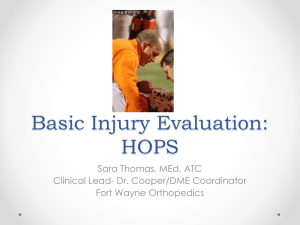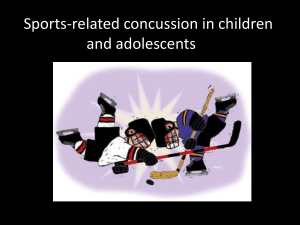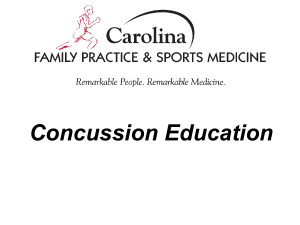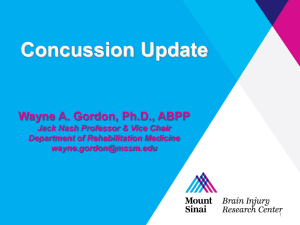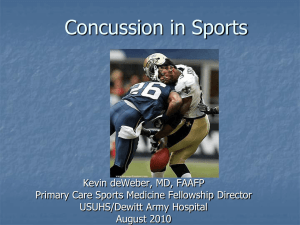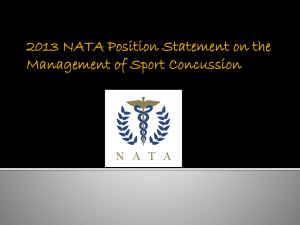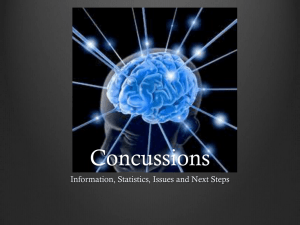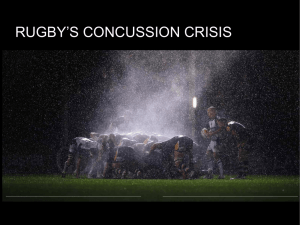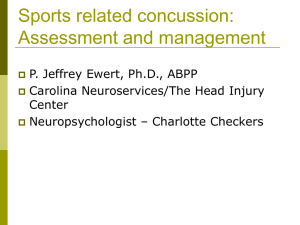NATA Research & Education Foundation Sponsored Presentation
advertisement
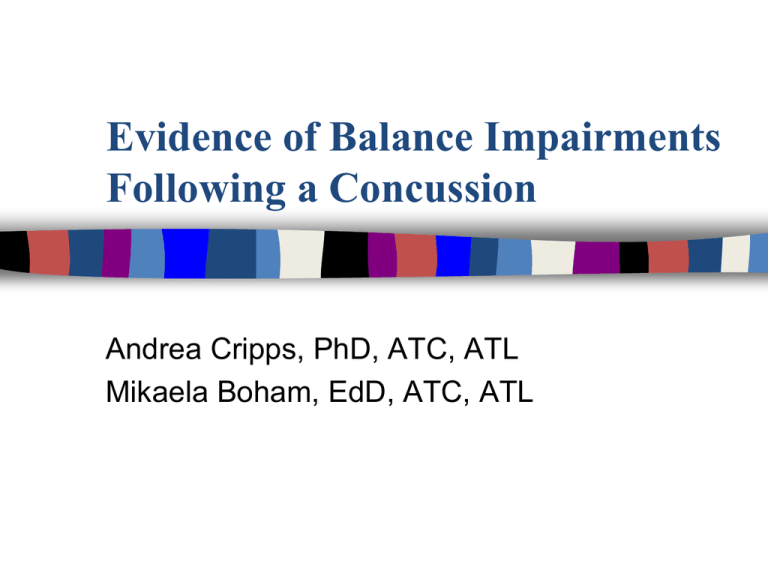
Evidence of Balance Impairments Following a Concussion Andrea Cripps, PhD, ATC, ATL Mikaela Boham, EdD, ATC, ATL Objectives • At the conclusion of the program participants should be able to: • Identify signs and symptoms of a concussion including balance deficits. • Understand the current research in support of conducting balance assessments at pre-season and post-injury. • Begin to understand visuo-motor processing impairments and their impact on the balance assessments. • Assess balance deficits using a variety of methods. • Identify evidence-based practices in determining therapeutic rehabilitation for the balance impaired athlete. • Identify the best practices for returning a concussed athlete who has suffered from balance impairments to participation. What is a Concussion??? A complex pathophysiological process affecting the brain, induced by biomechanical forces (Aubry, 2002; International Concussion in Sport Group, 2013; McCrory, 2008) Common Features of Concussion • Concussions: • may be caused by a direct blow to the head, face, neck, or elsewhere on the body with an ‘impulsive’ force transmitted to the head; • typically result in rapid onset of short-lived impairment of neurological function that resolve spontaneously; • may result in neuropathological changes but the acute clinical symptoms largely reflect a functional disturbance rather than a structural injury; Common Features of Concussion • result in a graded set of clinical symptoms that may or may not involve LOC • resolution of clinical and cognitive symptoms typically follow a sequential course Background on Concussion • $76.5 billion direct and indirect medical costs associated with traumatic brain injury (Finkelstein, 2006) • CDC reports that ~75% of all TBI’s are classified as mild (CDC, 2003) Background • 1.6-3.8 million reported concussion annually (Langlois, 2006) • 250,000 sport related concussions in a high school football season alone (Grindel, 2003) ► 68% between 10-19 years old (Gilcrest, 2011) Background • 22% of all high school injuries are classified as concussion (Comstock, 2012) • 56% of all concussion go unreported (Guskiewicz, 2000) Legislative Consequences SIGNS & SYMPTOMS OF CONCUSSION Somatic • • • • Headache Nausea Vomiting Balance difficulty/dizziness • Numbness/tingling • Sensitivity to light/noise Piland, JAT, 2003 Neurobehavioral • Fatigue • Trouble falling asleep • Sleeping more than usual • Drowsiness • Sadness • Nervousness Piland, JAT, 2003 Cognitive • Feeling “slowed down” • Feeling “in a fog” • Difficulty concentrating • Difficulty remembering Piland, JAT, 2003 Clinical Signs & Symptoms • • • • LOC Amnesia Disorientation Changes in attitude/emotional state/energy PRE-SEASON/POST-INJURY TESTING Baseline Testing • Conducted prior to sport participation • Conducted annually (especially in middle/high-school) • Conducted in all athletes at high risk of concussion • Research = fair on baseline testing & which athletes to test Baseline Testing • Method of baseline testing be the same for post-concussion testing • Conducted in an environment similar to practice/game • Research = poor on consistent method & environment • Athlete should be free of injury/illness during testing • Medication intake should be well documented • Research = fair Post-Concussion Testing • Timing & Frequency • Asymptomatic vs. Immediately following injury? • Research = poor for either approach • Recommendations are to wait until athlete is asymptomatic RETURN-TO-PLAY FOLLOWING A CONCUSSION Returning An Athlete To Participation • Check state laws for: • Who can make RTP decisions • If there is a minimum time to begin protocol • May be dependent on the age of the athlete? • Evidence = fair RTP Protocol • RTP protocol should begin once athlete is asymptomatic for at least 24 hours (dependent on your state law), this RTP Protocol includes: • At least 24 hours between each step • Any provocation or return of symptoms means return to previous step • Evidence = poor, however highly recommended Returning An Athlete To Participation • All objective measures should be returned or better than baseline before athlete is returned to participation • Research = poor, most suggest that balance has not recovered by RTP Returning An Athlete To Participation • RTP decisions should not be solely based on one measure • Research = poor, however highly recommended BALANCE Balance Testing • Objective measure that does not require a neuropsychologist to interpret results • Two classifications of testing types • High technology (e.g. forceplate) • Low technology (e.g. BESS) Evidence for Balance Impairments Following Concussion • Balance impairments are commonly noted following concussion • Worst impairments between 24-48 hours after injury • Spontaneous recovery of balance typically occurs within 3- 10 days of the injury • Research = fair Where does balance come from? Visual Somatosensory Vestibular • Thought to be caused by a failure of the sensory systems to properly integrate SENSORY SYSTEM IMPAIRMENTS Visual Impairments • Emerging research suggests that visual system is impaired following a concussion • Underlying cause for balance impairments? Vestibular Impairments • Often overlooked in assessment, management, and rehab of concussed athletes • Linked to balance impairments Vestibular Ocular Testing/Training • • • • • • Smooth Pursuits • Dix-Hallpike Maneuver Convergence • Epley Maneuver Divergent • Dynamic Visual Saccades Acuity Test* Head Thrust Test Gaze Stabilization *requires equipment BALANCE TRAINING? Dynamic Balance Training/Testing • Little is understood regarding appropriate intervention and rehabilitation following concussion • Use of dual task training may help to reduce persistent symptoms Conclusions & Recommendations • Balance is an important diagnostic indicator of neurological impairment following concussion and should be assessed in an objective manner. • Balance should be objectively assessed at the sideline and serially in the clinic to track recovery as part of a multifaceted approach to concussion management. QUESTIONS?
